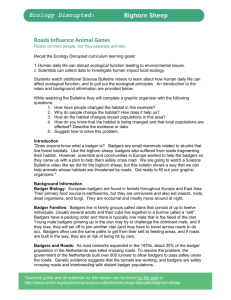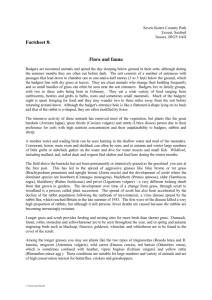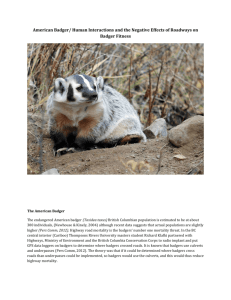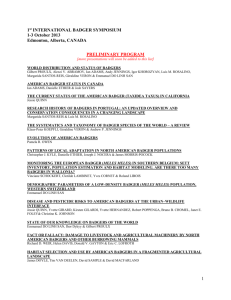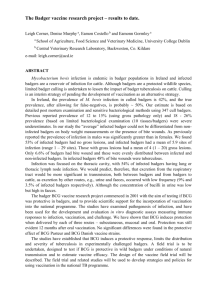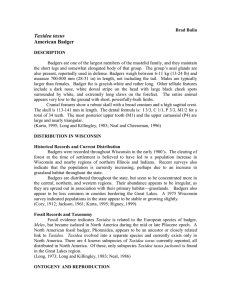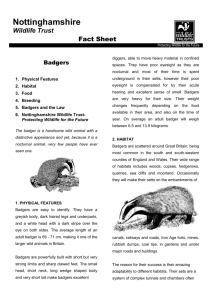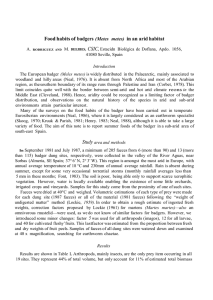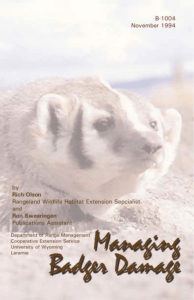Common Name (Scientific name)
advertisement
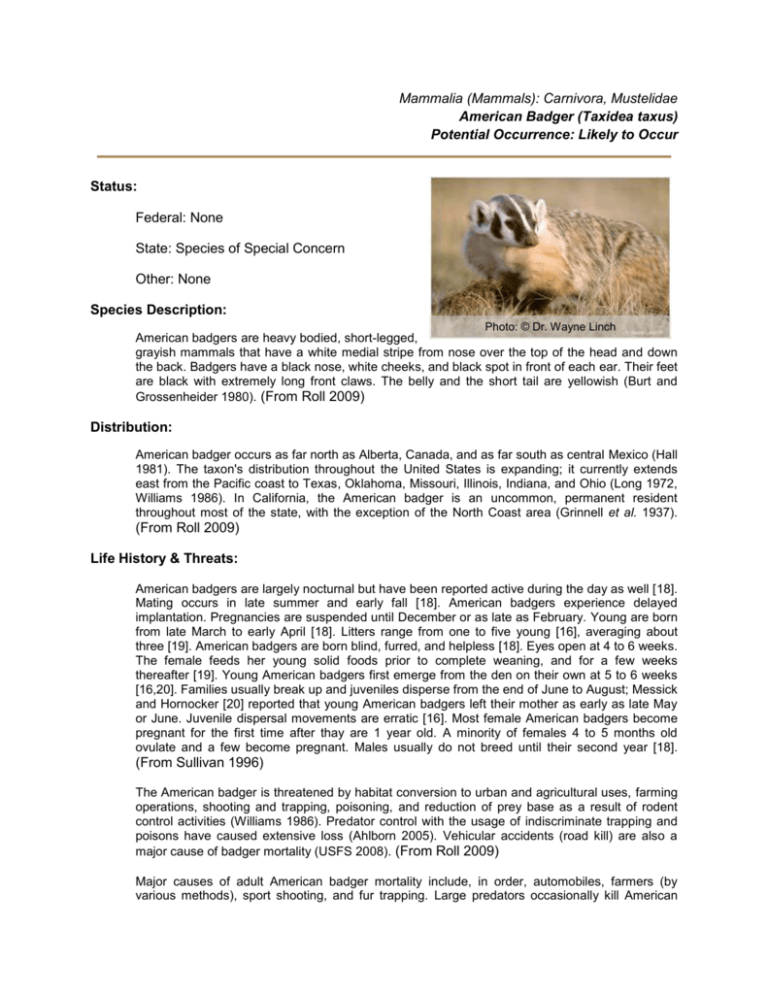
Mammalia (Mammals): Carnivora, Mustelidae American Badger (Taxidea taxus) Potential Occurrence: Likely to Occur Status: Federal: None State: Species of Special Concern Other: None Species Description: Photo: © Dr. Wayne Linch American badgers are heavy bodied, short-legged, grayish mammals that have a white medial stripe from nose over the top of the head and down the back. Badgers have a black nose, white cheeks, and black spot in front of each ear. Their feet are black with extremely long front claws. The belly and the short tail are yellowish (Burt and Grossenheider 1980). (From Roll 2009) Distribution: American badger occurs as far north as Alberta, Canada, and as far south as central Mexico (Hall 1981). The taxon's distribution throughout the United States is expanding; it currently extends east from the Pacific coast to Texas, Oklahoma, Missouri, Illinois, Indiana, and Ohio (Long 1972, Williams 1986). In California, the American badger is an uncommon, permanent resident throughout most of the state, with the exception of the North Coast area (Grinnell et al. 1937). (From Roll 2009) Life History & Threats: American badgers are largely nocturnal but have been reported active during the day as well [18]. Mating occurs in late summer and early fall [18]. American badgers experience delayed implantation. Pregnancies are suspended until December or as late as February. Young are born from late March to early April [18]. Litters range from one to five young [16], averaging about three [19]. American badgers are born blind, furred, and helpless [18]. Eyes open at 4 to 6 weeks. The female feeds her young solid foods prior to complete weaning, and for a few weeks thereafter [19]. Young American badgers first emerge from the den on their own at 5 to 6 weeks [16,20]. Families usually break up and juveniles disperse from the end of June to August; Messick and Hornocker [20] reported that young American badgers left their mother as early as late May or June. Juvenile dispersal movements are erratic [16]. Most female American badgers become pregnant for the first time after thay are 1 year old. A minority of females 4 to 5 months old ovulate and a few become pregnant. Males usually do not breed until their second year [18]. (From Sullivan 1996) The American badger is threatened by habitat conversion to urban and agricultural uses, farming operations, shooting and trapping, poisoning, and reduction of prey base as a result of rodent control activities (Williams 1986). Predator control with the usage of indiscriminate trapping and poisons have caused extensive loss (Ahlborn 2005). Vehicular accidents (road kill) are also a major cause of badger mortality (USFS 2008). (From Roll 2009) Major causes of adult American badger mortality include, in order, automobiles, farmers (by various methods), sport shooting, and fur trapping. Large predators occasionally kill American badgers [16]. Yearly mortality has been estimated at 35 percent for populations in equilibrium [14]. Lindzey [14] reported that average longevity was 9 to 10 years in the wild. The longevity record for wild American badgers is 14 years; a captive American badger lived at least 15 years 5 months [16]. (From Sullivan 2010) Habitat & Habitat Associations: American Badgers require a range of 25-100 acres of herbaceous, shrub or open habitat with friable soil to create burrows (Laudenslayer. 2007). Scrub, annual grasslands, woodlands (Laudenslayer 2007). American badgers are found in a variety of open, arid habitats, but are most commonly associated with grasslands, savannas, mountain meadows, and open areas of desert scrub (Stephenson and Calcarone 1999). They are usually absent from mature chaparral (Quinn 1990). Principle habitat requirements for the species include sufficient prey base, friable soils, and relatively open, uncultivated ground (Williams 1986). They are primarily found in areas of low to moderate slope (Stephenson and Calcarone 1999). The elevational range of the badger extends from below sea level to over 3,600 meters (12,000 ft) (Lindzey 1982). (From Roll 2009) American badgers occur primarily in grasslands, parklands, farms, and other treeless areas with friable soil and a supply of rodent prey [1,6]. They are also found in forest glades and meadows, marshes, brushy areas, hot deserts, and mountain meadows. (From Sullivan 1996) Conceptual Basis for GIS Model Development: Potential habitat for American Badger was mapped in the Study Area as: grassland chaparral (i.e., mixed chaparral and scrub oak) Possible best habitat was mapped as low to moderate slopes (< 17 degrees). Potential Occurrence in the Galbreath Wildlands Preserve: Habitat: American Badgers prefers open, arid grasslands and scrub. These habitats are small and patchily distributed in the Preserve (Figure 101). The map provides an overestimate of the amount of potential habitat for this species. American Badgers are absent from mature chaparral. Available GIS layers do not provide canopy cover estimates for chaparral and the distribution of open chaparral where this species occur could not be identified. Habitat quality of the grassland areas for this species is good in that it occurs in areas with low to moderate slope preferred by Badgers. However, the abundance and distribution of the potential habitat suggests that Preserve lands may be inadequate to support many individuals. American Badgers require 25 to 100 acres of herbaceous, scrub or open grassland to establish home ranges and grassland patch sizes appear to rarely meet these requirements, Nearest Occurrence: Documented Occurrences in the Preserve: This species has not been documented in the Preserve. To our knowledge, no surveys have been conducted. Nearest Occurrence to Preserve: The American Badger has not been reported to occur in USGS quads adjacent to the Study Area, but is widespread throughout North America. Summary: We anticipate that the American Badger is “Likely to Occur” in that individuals may use portions of the Preserve as part of their home ranges. Grasslands and open shrub land preferred by this species are not present on the Preserve in sufficient size or quantity to anticipate the establishment of home ranges. References Ahlborn, G. 1990. American Badger. California Wildlife Habitat Relationships System. <http://nrm.dfg.ca.gov/FileHandler.ashx?DocumentID=2597> 2010 June 16. Laudenslayer, WF. 2007 October. Species Notes for American Badger. California Wildlife Habitat Relationships (CWHR) System Level II Model Prototype. <http://nrm.dfg.ca.gov/ FileHandler.ashx?DocumentID=7137> 2010 June 16. Linch, Wayne. American Badger Photo. The Blind Photographer. <http://www.canadiannaturephotographer.com/ waynelynch.html> 2010 June 16. Roll, Mark. 2009 April 20. Yolo Natural Heritage Program-Draft Species Accounts-American Badger. Technology Associates. <http://www.yoloconservationplan.org/yolo_pdfs/ speciesaccounts/mammals/badger.pdf> 2010 June 16. Sullivan, Janet. 1996. Taxidea taxus. In: Fire Effects Information System, [Online]. U.S. Department of Agriculture, Forest Service, Rocky Mountain Research Station, Fire Sciences Laboratory (Producer). <http://www.fs.fed.us/database/feis/> 2010 July 7. Species Account Description: Emily Harvey
